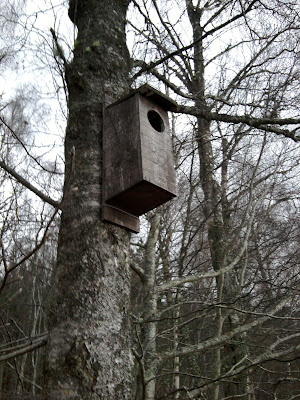After a week of sub-zero temperatures, today’s walk in Strathspey found a slight thaw underway. The weather was changeable with drizzle, mist, flurries of snow and some persistent rain. Some localities seemed devoid of birds but there was a steady supply of interesting sightings to keep out the cold. Arriving in Kingussie, two Collared Doves were among the typical village species including House Sparrow and Chaffinch. Ninety Jackdaws were over the Dell Road. Nearer the Spey, a finch flock in a weedy field was made up predominantly of Goldfinches (c20) but contained 10 Redpolls, a Siskin and a possible Twite. A Buzzard called nearby and a Dipper was on the ice-free part of the river.
The first tit flock of the day, in the damp woodland west of Ruthven Barracks, contained Great Tit, Blue Tit, Coal Tit and Treecreeper. More small birds at the feeders at the RSPB Insh Marshes Visitor Centre included the three common tit species and a Great-spotted Woodpecker. The first of two Ravens for the day flew over the marshes but other birds were absent due to the icy conditions. The marshes did however produce the sighting of the day in the form of a pair of Peregrines calling and displaying overhead. After five minutes of circling and some dramatic close passes, the male headed off north. At this point, another raptor rose to challenge him. Its small size (about two thirds of the size of the tiercel) and attenuated shape revealed it to be a Merlin. After a brief skirmish, the Peregrine continued on its way.
A Pheasant and Feral Pigeon were at Invertromie Farm and a
pair of Bullfinches were beside the river opposite Tromie Mills. A set of
tracks in the snow running from the farm almost as far as Tromie Bridge could
have been made by a “Highland Tiger”, but could equally have belonged to a farm cat.
Another mammal encounter involved a Stoat (with patches of ermine) which scampered
across the road, then straight up and over a wall at Old Milton.
Two Treecreepers and a Raven were between Old Milton and Insh. A Jay was near the centre of Insh and 30 Chaffinches were feeding on rough pasture east of the village. A detour down to the marshes at Lynachlaggan found seven Mute Swans, eighteen Mallards, five Wigeon, a pair of Goldeneye and a Grey Heron on a drainage channel. Nearby were Great-spotted Woodpecker and Hooded Crow.
Entering Farr Woods, the first bird seen was a male Brambling in a tree overlooking the road. The second was a Woodcock which got up from near the path. Loch Insh was mostly frozen with only a few Carrion Crows scavenging on the ice. Twelve Greylag Geese flying over added to the eerie atmosphere. Seven domestic Mallards were with twelve wild types near the water sports centre where four Long-tailed Tits were the only ones seen all day. As dusk fell, two Goldeneye were under Spey Bridge and up to 40 gulls (possibly Lesser black-backed) flew west overhead. The walk back to Aviemore was not particularly pleasant due to darkness, driving rain and heavy traffic.
The total bird count for the day was 39 species: Mute Swan, Greylag Goose, Wigeon, Mallard, Mallard (domestic), Goldeneye, Pheasant, Grey Heron, Buzzard, Merlin, Peregrine, Woodcock, Feral Pigeon, Collared Dove, Great Spotted Woodpecker, Jay, Jackdaw, Carrion Crow, Hooded Crow, Raven, Goldcrest, Blue Tit, Great Tit, Coal Tit, Long-tailed Tit, Treecreeper, Wren, Dipper, Blackbird, Mistle Thrush, Robin, Dunnock, House Sparrow, Chaffinch, Brambling, Goldfinch, Siskin, Redpoll and Bullfinch.
Impressions of Strathspey in December:
It’s quite lifeless in places, with some areas apparently
devoid of birds in spite of good watching conditions. Tit flocks were not
nearly as numerous or widespread as earlier in the year. Most small birds
seemed to be concentrated around the villages
It’s fairly colourless, although patches of withered bracken
added a bit of colour
It’s dramatic, with icicles and the frozen margins of lochs
and rivers adding extra detail to the landscape. The emptiness of the landscape
also accentuates the birds which ARE present such as over-flying geese and
displaying raptors
It’s quite dark, with the sun not rising to any great
height, and an impossibly short day-length








0 Comments:
Post a Comment
<< Home